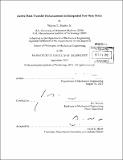| dc.contributor.advisor | J.G. Brisson. | en_US |
| dc.contributor.author | Staats, Wayne Lawrence | en_US |
| dc.contributor.other | Massachusetts Institute of Technology. Dept. of Mechanical Engineering. | en_US |
| dc.date.accessioned | 2013-03-28T18:11:35Z | |
| dc.date.available | 2013-03-28T18:11:35Z | |
| dc.date.copyright | 2012 | en_US |
| dc.date.issued | 2012 | en_US |
| dc.identifier.uri | http://hdl.handle.net/1721.1/78179 | |
| dc.description | Thesis (Ph. D.)--Massachusetts Institute of Technology, Dept. of Mechanical Engineering, 2012. | en_US |
| dc.description | Cataloged from PDF version of thesis. | en_US |
| dc.description | Includes bibliographical references (p. 205-211). | en_US |
| dc.description | A higher quality version of this thesis is available at: http://hdl.handle.net/1721.1/80414 | |
| dc.description.abstract | Modern computer processors require significant cooling to achieve their full performance. The "efficiency" of heat sinks is also becoming more important: cooling of electronics consumes 1% of worldwide electricity use by some estimates. Unfortunately, current cooling technologies often focus on improving heat transfer at the expense of efficiency. The present work focuses on a unique, compact, and efficient air cooled heat sink which addresses these shortcomings. While conventional air cooled heat sinks typically use a separate fan to force air flow over heated fins, the new design incorporates centrifugal fans directly into the body of a loop heat pipe with multiple planar condensers. These "integrated fans" rotate between the planar condensers, in close proximity to the hot surfaces, establishing a radially outward flow of cooling air. The proximity of the rotating impellers to the condenser surfaces results in a marked enhancement in the convective heat transfer coefficient without a large increase in input power. To develop an understanding of the heat transfer in integrated fan heat sinks, a series of experiments was performed to simultaneously characterize the fan performance and average heat transfer coefficients. These characterizations were performed for 15 different impeller profiles with various impeller-to-gap thickness ratios. The local heat transfer coefficient was also measured using a new heated-thin-film infrared thermography technique capable of applying various thermal boundary conditions. The heat transfer was found to be a function of the flow and rotational Reynolds numbers, and the results suggest that turbulent flow structures introduced by the fans govern the transport of thermal energy in the air. The insensitivity of the heat transfer to the impeller profile decouples the fan design from the convection enhancement problem, greatly simplifying the heat sink design process. Based on the experimental results, heat transfer and fan performance correlations were developed (most notably, a two-parameter correlation that predicts the dimensionless heat transfer coefficients across 98% of the experimental work to within 20% relative RMS error). Finally, models were developed to describe the scaling of the heat transfer and mechanical power consumption in multi-fan heat sinks. These models were assessed against experimental results from two prototypes, and suggest that future integrated fan heat sink designs can achieve a 4x reduction in thermal resistance and 3x increase in coefficient of performance compared to current state-of-the-art air cooled heat sinks. | en_US |
| dc.description.statementofresponsibility | by Wayne L. Staats, Jr. | en_US |
| dc.format.extent | 211 p. | en_US |
| dc.language.iso | eng | en_US |
| dc.publisher | Massachusetts Institute of Technology | en_US |
| dc.rights | M.I.T. theses are protected by
copyright. They may be viewed from this source for any purpose, but
reproduction or distribution in any format is prohibited without written
permission. See provided URL for inquiries about permission. | en_US |
| dc.rights.uri | http://dspace.mit.edu/handle/1721.1/7582 | en_US |
| dc.subject | Mechanical Engineering. | en_US |
| dc.title | Active heat transfer enhancement in integrated fan heat sinks | en_US |
| dc.type | Thesis | en_US |
| dc.description.degree | Ph.D. | en_US |
| dc.contributor.department | Massachusetts Institute of Technology. Department of Mechanical Engineering | |
| dc.identifier.oclc | 829793532 | en_US |
